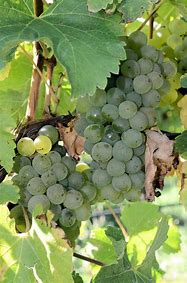Sampling Sauvignon Blanc
Since the inception of Pursuing Pinot in 2011, content has been focused on experiences – travel, wineries, vineyards, tastings, and restaurants. All of these have been in short supply during the past 11 months of pandemic. Therefore, I thought it might be interesting to explore some of the most popular wine varietals, starting with Sauvignon Blanc. My daughter, Hilary, and two other friends joined me for an informal tasting of three Sauvignon Blanc selections.
 Sauvignon Blanc grows in many regions around the world including New Zealand, California, France, Chile, Washington State, Australia, and several others. New Zealand made its mark on the wine world with the unmistakable flavors of the Sauvignon Blanc made in Marlborough. Many of California’s wine growing areas produce Sauvignon Blanc and the most famous French wines made from this grape are Sancerre and Pouilly Fumé. The wines for this article and tasting are from France, California, and New Zealand.
Sauvignon Blanc grows in many regions around the world including New Zealand, California, France, Chile, Washington State, Australia, and several others. New Zealand made its mark on the wine world with the unmistakable flavors of the Sauvignon Blanc made in Marlborough. Many of California’s wine growing areas produce Sauvignon Blanc and the most famous French wines made from this grape are Sancerre and Pouilly Fumé. The wines for this article and tasting are from France, California, and New Zealand.
“Sauvignon” comes from the French word “sauvage,” meaning wild. The sauvignon blanc grape is not easy to cultivate because left on its own, it can grow out of control. Growers must balance demand for the grape against the extra vineyard management that is required. And demand is high as the wines made from sauvignon blanc are acidic and very food friendly. The wines burst with all things green including fruits, vegetables, herbs, grass, and tea. Some have undertones of tropical fruit and some show great minerality.
Let’s start in France, where sauvignon blanc is believed to have originated in the Loire Valley. Sancerre is made from grapes grown on the left bank of the Loire River in soils that are primarily limestone, clay, and chalk. Most of the wines produced are aged in stainless steel to protect the fresh, acidic qualities. For this article, I chose a 2019 Sancerre from Domaine Merlin-Cherrier, made by fourth generation, artisan wine maker Thierry Merlin. The vineyard soils are a combination of gravel mixed with limestone and chalk on top of clay. This was the first wine our group tasted and it was described as clean, dry, acidic, with a definitive mineral component. One of our group detected a tart grapefruit aroma, typical of sauvignon blanc. We agreed it would be excellent with food, especially something creamy, because of the sensation of palate cleansing with each sip.
Next, we’ll move on to California. It is believed that sauvignon blanc was brought to California from Bordeaux. As noted above, the relative difficulty of cultivating this variety kept many growers from investing in it, but over the past decade or so, demand has risen and the grape is being much more widely cultivated. The styles of sauvignon blanc wines differ dramatically by region and wine maker. While all retain the fresh, green, and acidic qualities expected from sauvignon blanc, the wine making and aging technique can result in wines of greater depth and character. The California wine chosen for our tasting was Chalk Hill Estate 2018 from Sonoma County. First impressions were immediate – that there was a lot going on in this wine. Pineapple was identified as an aroma, also something that seemed almost syrupy, although the wine is very dry. The alcohol content surprised us, at 14.5 percent, which led to a bit of a bite. It was also apparent that the wine had seen some oak – upon further exploration, I found that it was about 60 percent oak to 40 percent stainless steel. This is not a sipping wine, it definitely needed food and it might need additional aging to mellow the edginess.
*Footnote – I had a glass of the Chalk Hill with roast chicken a couple of days after our tasting – perfect pairing.
Finally, it was time to taste our New Zealand sauvignon blanc. This grape is central to the country’s wine identity, the leading variety and the wine that dominates export. The best are made in Marlborough and are zingy and green but frequently have the tropical fruit backdrop of mango, papaya, or passion fruit. Nearly all are fermented in stainless steel, but a few wineries ferment a small portion of the wine in neutral oak and then blend it in, resulting in a rounder, more complex wine. For the tasting, I found myself drawn to a wine I had not tasted previously, 2018 Spy Valley. For the record, I have not had a bad sauvignon blanc from the Marlborough region and most of the wines are reasonably priced at under $20.00. Spy Valley is a family owned and operated winery producing sustainably produced wines. As we approached this wine, we didn’t think it smelled or tasted like the typical Marlborough sauvignon blanc. It seemed to have a more complex nose with pronounced tropical notes and grassy flavors on the palate. Spy Valley does ferment a small portion of their sauvignon blanc in oak, so that contributed to the aromas that seemed somewhat atypical. The Spy Valley label was incredible – they included everything you would want to know on the label – region, sub-region, vineyard, wine making notes, wine maker, viticulturist and more. None of us had ever seen a wine bottle label containing so much detail.
Our group agreed that the Sancerre was the wine we enjoyed the most. The tasting was fun and informative and we are looking forward to doing more of these in the coming months.
Cheers, everyone!



 Lisa Gorham
Lisa Gorham